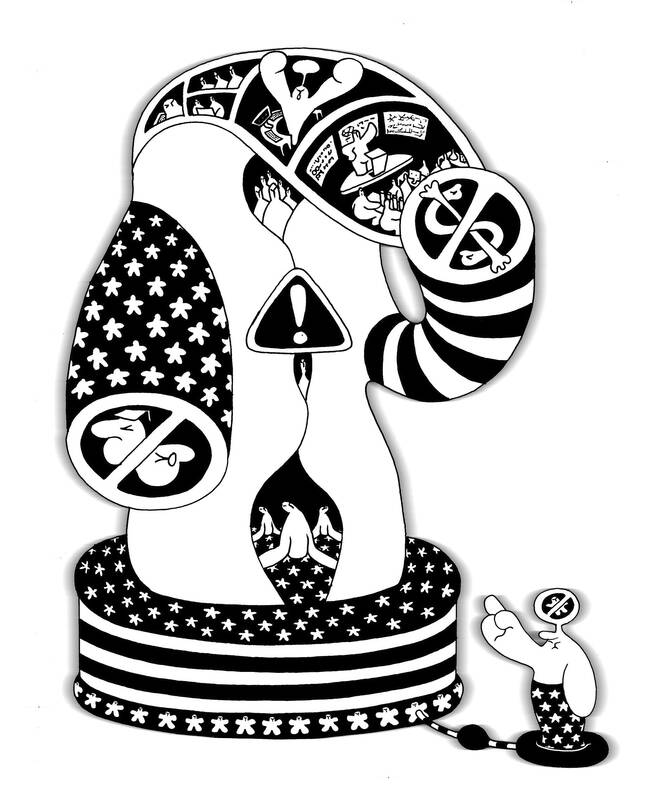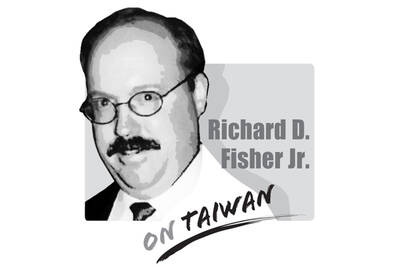Harvard University is imposing a temporary freeze on hiring faculty. Columbia University is grappling with cuts to US$400 million in federal funding. California Institute of Technology is leaving postdoctoral positions unfilled. A University of Washington researcher is wondering about a climate and health grant after a government site was taken offline.
These are just some of the disruptions that resulted from US President Donald Trump’s sweeping changes to the federal government. Although the private sector has historically provided more funding for research and development in the US, Trump’s mass firings and freezing of billions of dollars appropriated by the US Congress could have ripple effects on the US scientific enterprise for years to come, experts say.
Many personnel and financial cuts are being made under the banner of streamlining government — an idea championed by billionaire Tesla Inc CEO Elon Musk and his Department of Government Efficiency — while some funding cancelations and threats are tied to allegations of anti-Semitism on campus. Several of these moves have been challenged in court, and the implementation of some have been put on hold.

Illustration: Mountain People
However, research has already been halted in some places and thrust others into limbo, according to interviews with more than 25 professors, graduate students, other academic researchers, and experts across the public, private and non-profit sectors.
The cutbacks risk slowing the pipeline of US-grown science talent, experts warn. Should the Congress enshrine them, it would radically alter a system that’s allowed the US to become a world-leading hub for research since World War II. This is possible in the short-term spending legislation under debate as a possible government shutdown looms or in the next longer-term budget.
“This is an ecosystem that benefits everyone and has kept the US at the forefront,” Fiona Harrison, the chair of Caltech’s division of physics, mathematics and astronomy, wrote in an e-mail.
“The situation is jeopardizing our Nation’s ability to stay at the forefront of science and engineering by reducing or eliminating a generation of young technical talent,” she added.
The US government has been an essential source of data for fields from weather to health. For example, investment in the US National Weather Service (NWS) and its support functions has enabled the growth of a commercial weather forecasting industry.
Those systems generate at least US$85 billion in economic benefits, or more than 20 times what the government spends, said Jeffrey Lazo, an independent economist who tracks the value of US forecasting services.
“Without the federal data and observations, it would be very difficult to say there would be any private weather enterprise,” he said.
Due to recent firings and voluntary departures of hundreds of people at the US National Oceanic and Atmospheric Administration (NOAA), which oversees the NWS, three local forecasting offices have cut back on collecting basic data, with one site in Kotzebue, Alaska, discontinuing weather balloon launches altogether.
“The remote launch sites are where some of the most valuable data comes from,” said John Dean, cofounder of artificial intelligence weather forecasting start-up WindBorne Systems.
“Losing these observations means that our forecast quality will degrade,” he said.
The company — which collects data using its own weather balloons — is talking with the NOAA about how it can fill newly created gaps, Dean said.
The agency confirmed it was in touch with the start-up, adding the matter is “still under review at NWS.”
Last month, the US National Institutes of Health (NIH) said it was slashing rates to 15 percent for overhead in grants, which awardees can use to cover the indirect costs of everything from building maintenance to tech support. The institute commonly covers more than half of those costs. While a Massachusetts district court judge put a hold on cuts last week, the potential change is weighing on researchers.
“Every day, there’s something new and something I was not ready for and my colleagues weren’t ready for,” University of Chicago sociologist Alexandra Tate said.
Tate has two NIH grant proposals, worth about US$650,000 combined, in limbo.
“I don’t know where my career’s going from here,” she said.
Grant cancelations at other agencies are already leading to job losses.
The US Social Security Administration notified researchers at a consortium of six academic centers that their multi-year grant worth more than US$70 million was abruptly canceled on Feb. 20, said Teresa Ghilarducci, a researcher impacted by the grant cancelation and chair of the economic department at the New School in New York City (She is a former columnist at Bloomberg Opinion).
This canceled grant — which funded research into retirement that informed federal policymaking — has impacted the work of more than 50 people at the University of Wisconsin-Madison, including the termination of five senior researchers, said Ghilarducci, who anticipates more job losses at the other centers.
The White House, Social Security Administration and Department of Health and Human Services did not respond to requests for comment.
As individual researchers wrestle with funding restrictions, US universities are responding by limiting spending in ways that would impact operations over the coming calendar years.
Harvard, Stanford University, the University of Pennsylvania and the Massachusetts Institute of Technology have recently announced hiring freezes. Meanwhile, Johns Hopkins University is cutting about 2,000 positions globally and about 250 in the US following the termination of more than US$800 million in US Agency for International Development grants. The university is the top recipient of research funding and NIH money.
“This is not one standard deviation away from normal. This is not even two standard deviations away from normal. This is way out on the extreme,” said Suresh Venkatasubramanian, a computer scientist at Brown University and an assistant director in former US president Joe Biden’s Office of Science and Technology Policy.
Researchers at the start of their careers are particularly vulnerable. West Virginia University says it is limiting admission to health science doctoral programs due to “unforeseen budgetary challenges.”
Citing “uncertainties with funding” and high acceptance rates, Iowa State University said some departments have rescinded offers to graduate students who had not formally accepted their spots.
“Unfortunately, the full force of the Trump cuts on science were only evident after we sent offers to grad students,” Harrison said. While Caltech would not rescind offers, “we will very likely be drastically reducing admissions next year” and might even not admit “any graduate students at all in many areas of science and math,” she said.
The US economy has been intimately tied to the science enterprise since World War II. The Federal Bank of Dallas estimates that the rate of return for non-defense government research and development over the past 80 years ranges 150 percent to 300 percent, suggesting that this federal funding effectively pays for itself over time.
While the private sector provides the largest share of research and development funding in the US, the federal government provides a crucial backstop, including for science with no immediate hope of commercialization, according to the National Science Foundation (NSF).
The private sector would feel the impact of losing “basic research in areas that they do not and cannot fund themselves,” said Diane Souvaine, a computer scientist at Tufts University and former NSF board chair.
“We would miss out on key areas and run the risk of technological surprise if there is too much federal pullback,” Souvaine said.
A drop in graduate students would also result in a shallower pool of experts for the biotech industry to hire, Northwestern University stem cell biologist and NIH grant recipient Carole LaBonne said.
As uncertainty grips US research institutions, other countries are trying to poach US talent. At least one French university is pitching itself as a “safe place for science.”
China, too, has been ramping up recruitment.
“We are already seeing China advertise for fired scientists to move and work there,” said US Representative Zoe Lofgren, the ranking Democrat on the House of Representatives Committee on Science, Space and Technology, in an e-mailed statement.
“We would be utterly foolish if we decided to give up the preeminence that we have had in scientific research,” said Shirley Tilghman, a former Princeton University president and molecular biologist.
US President Donald Trump created some consternation in Taiwan last week when he told a news conference that a successful trade deal with China would help with “unification.” Although the People’s Republic of China has never ruled Taiwan, Trump’s language struck a raw nerve in Taiwan given his open siding with Russian President Vladimir Putin’s aggression seeking to “reunify” Ukraine and Russia. On earlier occasions, Trump has criticized Taiwan for “stealing” the US’ chip industry and for relying too much on the US for defense, ominously presaging a weakening of US support for Taiwan. However, further examination of Trump’s remarks in

As the Chinese Communist Party (CCP) and its People’s Liberation Army (PLA) reach the point of confidence that they can start and win a war to destroy the democratic culture on Taiwan, any future decision to do so may likely be directly affected by the CCP’s ability to promote wars on the Korean Peninsula, in Europe, or, as most recently, on the Indian subcontinent. It stands to reason that the Trump Administration’s success early on May 10 to convince India and Pakistan to deescalate their four-day conventional military conflict, assessed to be close to a nuclear weapons exchange, also served to
China on May 23, 1951, imposed the so-called “17-Point Agreement” to formally annex Tibet. In March, China in its 18th White Paper misleadingly said it laid “firm foundations for the region’s human rights cause.” The agreement is invalid in international law, because it was signed under threat. Ngapo Ngawang Jigme, head of the Tibetan delegation sent to China for peace negotiations, was not authorized to sign the agreement on behalf of the Tibetan government and the delegation was made to sign it under duress. After seven decades, Tibet remains intact and there is global outpouring of sympathy for Tibetans. This realization
After India’s punitive precision strikes targeting what New Delhi called nine terrorist sites inside Pakistan, reactions poured in from governments around the world. The Ministry of Foreign Affairs (MOFA) issued a statement on May 10, opposing terrorism and expressing concern about the growing tensions between India and Pakistan. The statement noticeably expressed support for the Indian government’s right to maintain its national security and act against terrorists. The ministry said that it “works closely with democratic partners worldwide in staunch opposition to international terrorism” and expressed “firm support for all legitimate and necessary actions taken by the government of India